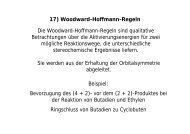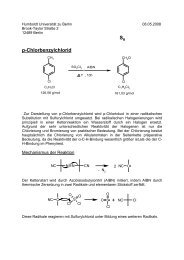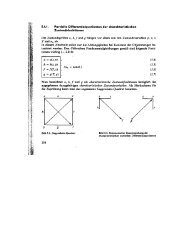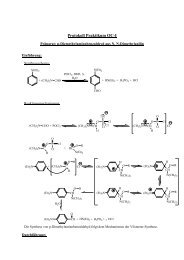Gas-Phase Reactions of Homo- and ... - Institut für Chemie
Gas-Phase Reactions of Homo- and ... - Institut für Chemie
Gas-Phase Reactions of Homo- and ... - Institut für Chemie
You also want an ePaper? Increase the reach of your titles
YUMPU automatically turns print PDFs into web optimized ePapers that Google loves.
Helvetica Chimica Acta ± Vol. 88 (2005) 1415<br />
dehydrogenation <strong>of</strong> butane by Ni ‡ 2 (up to three times), meanwhile atomic Ni ‡<br />
dehydrogenates this substrate only once [18].<br />
In addition to dehydrogenation <strong>of</strong> pentanenitrile by Ni ‡ 2 , ionic products with mass<br />
differences <strong>of</strong> Dm ˆ 29 <strong>and</strong> 30 are observed, which correspond to the combined losses<br />
<strong>of</strong> H 2 ‡ HCN <strong>and</strong> H 2 ‡ C 2H 4, respectively. Except for the combined H 2/HCN<br />
elimination, all other reaction channels <strong>of</strong> Ni ‡ 2 are also observed for CoNi ‡ . While<br />
the reaction efficiency <strong>of</strong> n-C 4H 9CN/CoNi ‡ is the highest among all systems studied, the<br />
major part <strong>of</strong> reactivity is due to single dehydrogenation in the products formed by the<br />
CoNi ‡ cluster, whereas for Ni ‡ 2 mainly double dehydrogenation is observed (Table 2).<br />
The consecutive losses <strong>of</strong> HCN or C 2H 4 after dehydrogenation are proposed to<br />
occur as a result <strong>of</strong> the processes exemplified for Ni ‡ 2 in Scheme 4: after dehydrogenation<br />
<strong>and</strong> subsequent insertion in the C CN bond (21 ! 22) either a b-H (22 ! 23)ora<br />
b-alkyl shift (22 ! 24) take place, both involving an allylic position; because the<br />
product isotope distributions for 11c/Ni ‡ 2 <strong>and</strong> 11d/Ni ‡ 2 are the same, the b-H migration<br />
(22 ! 23) quite probably is reversible.<br />
Scheme 4. Proposed Mechanism for the Eliminations <strong>of</strong> C 2H 4 <strong>and</strong> HCN, Respectively, from Pentanenitrile/Ni ‡<br />
2<br />
Subsequent to Dehydrogenation<br />
The resulting intermediates 23 <strong>and</strong> 24 then lead to the reductive elimination <strong>of</strong><br />
HCN <strong>and</strong> the evaporation <strong>of</strong> C 2H 4, respectively. In agreement with these suggestions,<br />
the product ion [Ni 2C 3H 3N] ‡ , for example, undergoes the secondary Reaction 36 in the<br />
presence <strong>of</strong> pentanenitrile. Quite possibly, the resulting ionic product [Ni 2C 7H 11N] ‡<br />
corresponds to a complex that contains an ethene <strong>and</strong> a pentenenitrile lig<strong>and</strong>, which are<br />
formed in course <strong>of</strong> HCN loss <strong>and</strong> bound to the Ni ‡ 2 core. Future studies are indicated<br />
to shed further light on questions like structural details or reactivity patterns <strong>of</strong> these<br />
novel metal cluster cations.<br />
[Ni 2C 3H 3N] ‡ ‡ n-C 4H 9CN ! [Ni 2C 7H 11N] ‡ ‡ HCN (36)<br />
Insertion <strong>of</strong> a transition-metal cation in a C CN bond has previously been<br />
discussed in a different context [25]. In these studies, the detailed electronic structure<br />
influence <strong>of</strong> the transition-metal cations Fe ‡ through Cu ‡ on their reactivities with 2methylbutanenitrile<br />
were probed <strong>and</strong> three major processes were identified: i) remote<br />
functionalization, ii) initial insertion into the C CN bond ( allylic mechanism ) in



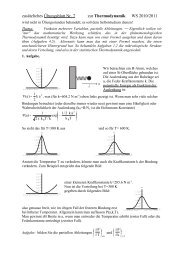
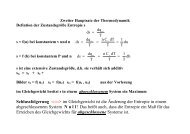
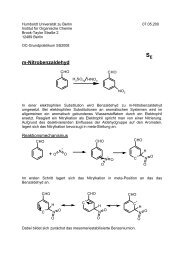
![Photoswitchable ionophores based on 1,3-alternate calix[4]arenes ...](https://img.yumpu.com/12290271/1/190x253/photoswitchable-ionophores-based-on-13-alternate-calix4arenes-.jpg?quality=85)
